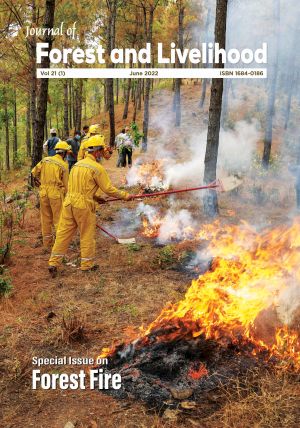Forest Fire in the Hindu Kush Himalayas: A Major Challenge for Climate Action
DOI:
https://doi.org/10.3126/jfl.v21i1.56576Keywords:
Active forest fire, climate action, HKH, precipitation, temperatureAbstract
Forest fire has been one of the compelling issues in the Hindu Kush Himalayan (HKH) region. To promote regeneration, clearing fields for agriculture, hunting, and security reasons, local people deliberately set forests on fire. In this paper, active fire incidents, temperature, precipitation, and the changes of Aerosol Optical Depth (AOD) and Carbon monoxide (CO) value associated with forest fire were evaluated. The active forest fire incidents obtained from the Moderate Resolution Imaging Spectroradiometer (MODIS) satellite are supplemented by the ERA5-land dataset to see the relation between precipitation and temperature with forest fires. MODIS and Tropospheric Monitoring Instrument (TROPOMI) sensor datasets were used to see the changes in AOD and CO in the region. MODIS sensor detected more than 30,462 active fires incidents in March and April 2021 in the study areas. Shan State of Myanmar recorded the maximum number of active fire incidents which is due to the practice of shifting cultivation and minimum in Bhutan due to the awareness campaigns and technology improvement. The temperature recorded in the study sites shows an increasing trend as compared to the reference period (2010-2020). Apart from Shan and Bago of Myanmar, precipitation in the study sites is also less during the study period. AOD and CO values show prominent peaks in a fire season which coincide with days of the maximum number of fire counts inferring the influence of forest fire on air quality. Developing countries like Nepal, India, Myanmar, and Bhutan are willing to take part in climate finance and are bound to accept expensive insurance premium due to forest fire incidents. Unless forest fires are effectively managed and mitigated, achieving Nationally Determined Contributions (NDCs) and global agendas, including United Nations Decade of Ecosystem Restoration is onerous.
Downloads
Downloads
Published
How to Cite
Issue
Section
License
Copyright (c) 2022 ForestAction Nepal

This work is licensed under a Creative Commons Attribution-NonCommercial 4.0 International License.
CC-BY-NC: This license allows reusers to distribute, remix, adapt, and build upon the material in any medium or format for noncommercial purposes only, and only so long as attribution is given to the creator.





